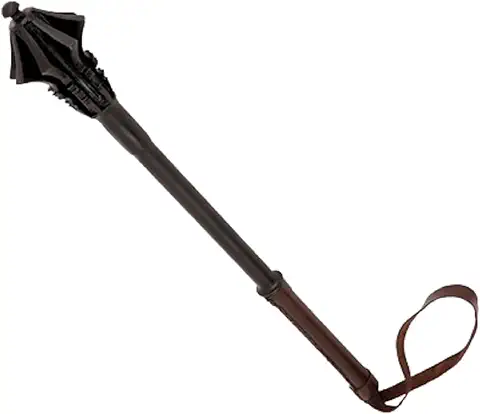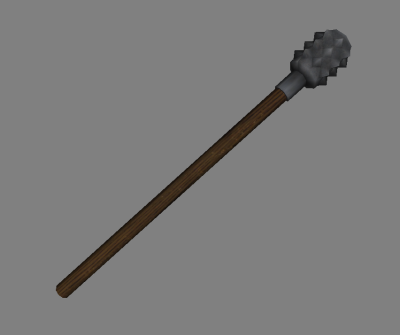~ The Mace
Medieval Weaponry ~
When swords and spears struggled to break through heavy armor, the mace emerged as a brutal and effective solution. Unlike edged weapons that relied on cutting or slicing, the mace was a pure blunt-force instrument, capable of crushing bone and denting steel. In the hands of a skilled warrior, the mace was simple, durable, and terrifyingly effective.
What Is a Mace?
A mace is a blunt, club-like weapon with a reinforced head designed to deliver powerful crushing blows. It is usually made of metal or wood, with a heavy striking end composed of steel, iron, or bronze. Unlike an axe or sword, a mace does not rely on a sharp edge. Instead, it concentrates force to break armor and cause trauma beneath protective gear.
Typical Features
- Length: Around 2 to 3 feet (60 to 90 cm)
- Weight: Typically 1.5 to 3 kg, depending on the design
- Construction: All-metal or a wooden shaft with a metal head
- Head design: Often flanged or knobbed to increase impact efficiency
- Grip: Usually fitted with a leather wrap or pommel for better handling
Origins and Early Use
The mace has ancient roots, with early versions dating back to Mesopotamia and Egypt. However, it gained widespread military use in medieval Europe during the 10th to 15th centuries, especially when plate armor became common. As knights and soldiers began wearing more metal protection, cutting weapons like swords became less effective. The mace, with its blunt trauma power, provided a solution.
Flanged vs. Knobbed Maces
There were several variations of the medieval mace:
- Flanged mace: Featured metal ridges or "flanges" to focus the blow onto a narrow point, increasing penetration through armor.
- Knobbed mace: Had a smooth or spiked spherical head, more common in earlier designs.
- Spiked mace: A more intimidating version, sometimes used more for psychological effect than battlefield practicality.

Check Amazon


Check Amazon
Flanged maces became the dominant type in the later Middle Ages because they performed better against steel plate armor.
Advantages of the Mace
- Armor penetration: Could crush or dent armor, causing injury without piercing
- Low maintenance: No blade edge to sharpen, very durable in combat
- Simple design: Easier and cheaper to produce than swords
- Usable by many: Could be effectively used with less training than edged weapons
Use in Battle
Maces were used by both infantry and cavalry. Mounted knights could swing a mace downward with force, while foot soldiers used them to break enemy lines or crush shields. In many cases, they were carried as secondary weapons, especially useful when facing armored opponents in close combat.
The mace also became associated with certain religious orders. Some legends suggest that clerics used maces instead of bladed weapons to avoid "shedding blood," though this is debated among historians.
Symbolism and Authority
Beyond the battlefield, the mace took on ceremonial and symbolic roles:
- Ceremonial maces: Represented power and authority in parliaments and religious institutions
- Military rank: Some maces were elaborately decorated and carried by high-ranking commanders
- Heraldry: Maces appeared in coats of arms and emblems
Limitations of the Mace
- Limited range: Shorter than polearms, requiring close combat
- Weight: Heavier than swords, could be tiring over time
- Requires strength: Most effective when wielded with powerful blows
Famous Examples and Users
While maces were used by soldiers across Europe, some of the most famous examples include:
- Polish Hussars: Often carried ceremonial maces as symbols of rank
- Holy Roman Empire: Imperial guards carried ornate maces
- Clerical orders: Sometimes depicted using maces rather than swords
Conclusion
The mace was a product of necessity. As armor became more advanced, so too did the weapons designed to defeat it. The mace proved that brute force was sometimes more effective than a sharp edge. Its simplicity, durability, and crushing power made it one of the most reliable tools of medieval combat.
Today, the mace survives as a symbol of authority and tradition, but its battlefield legacy remains a reminder of the raw, unforgiving nature of medieval warfare.